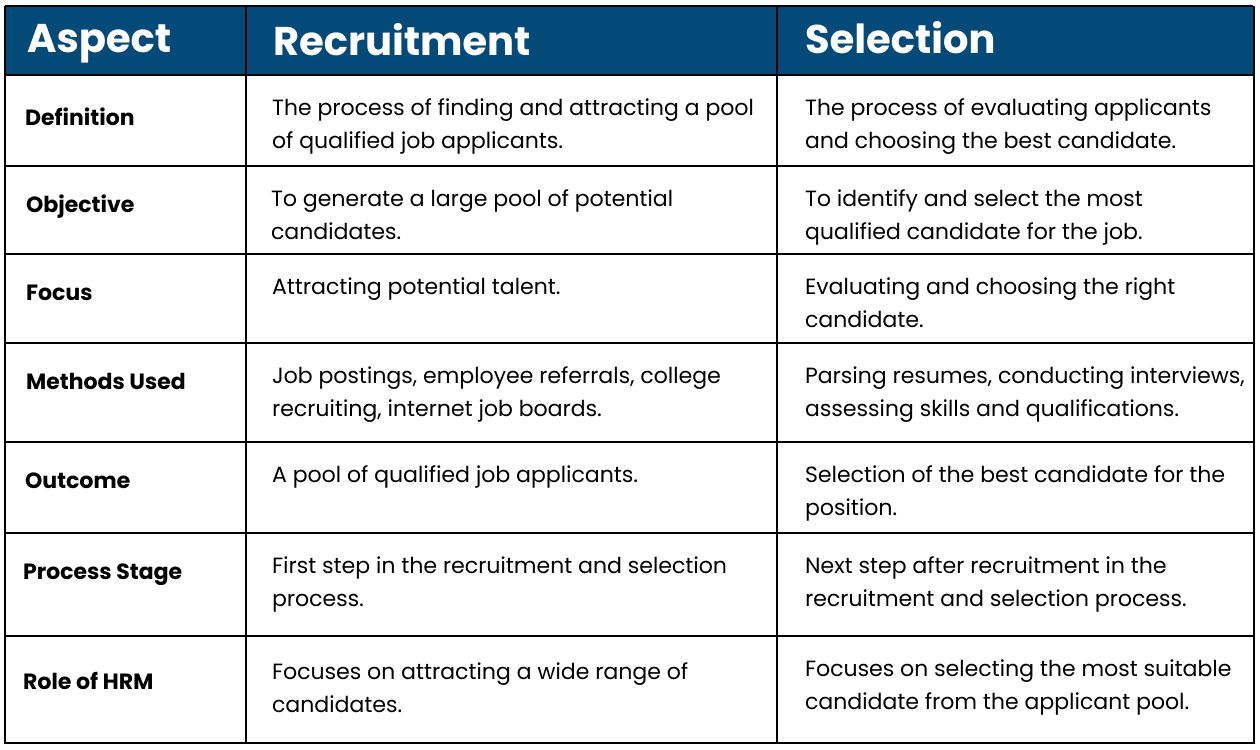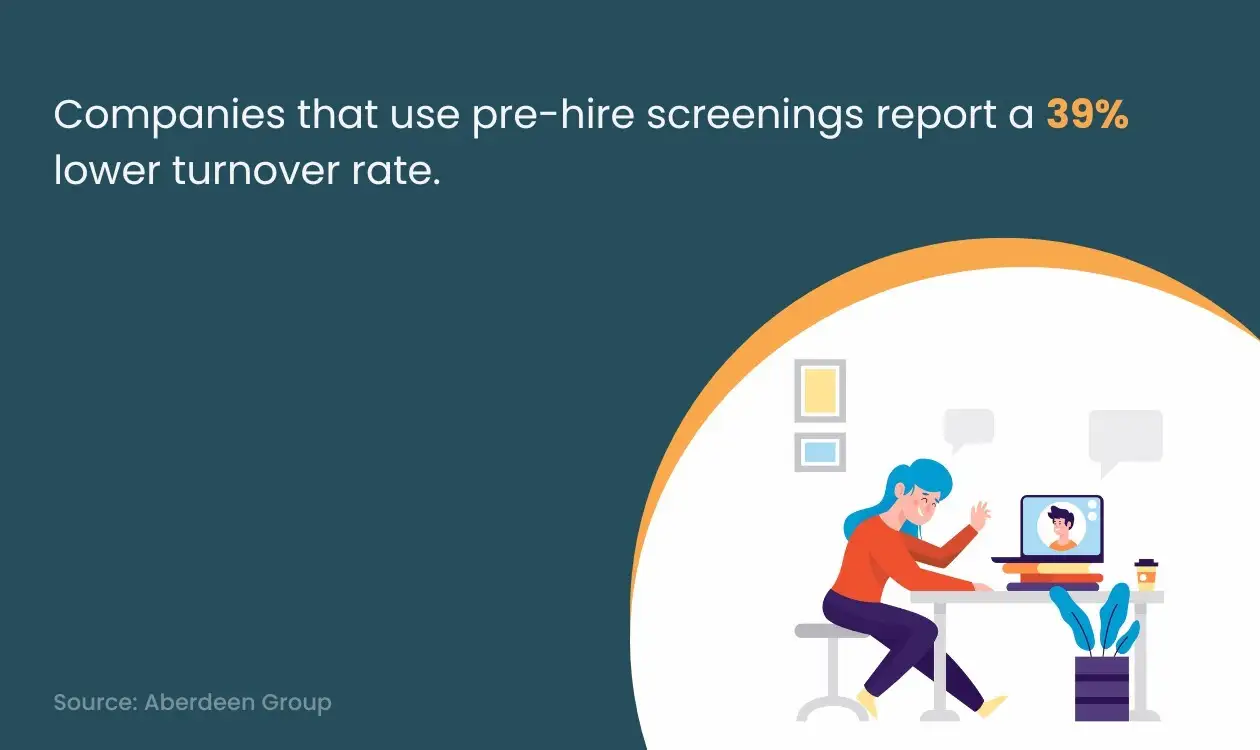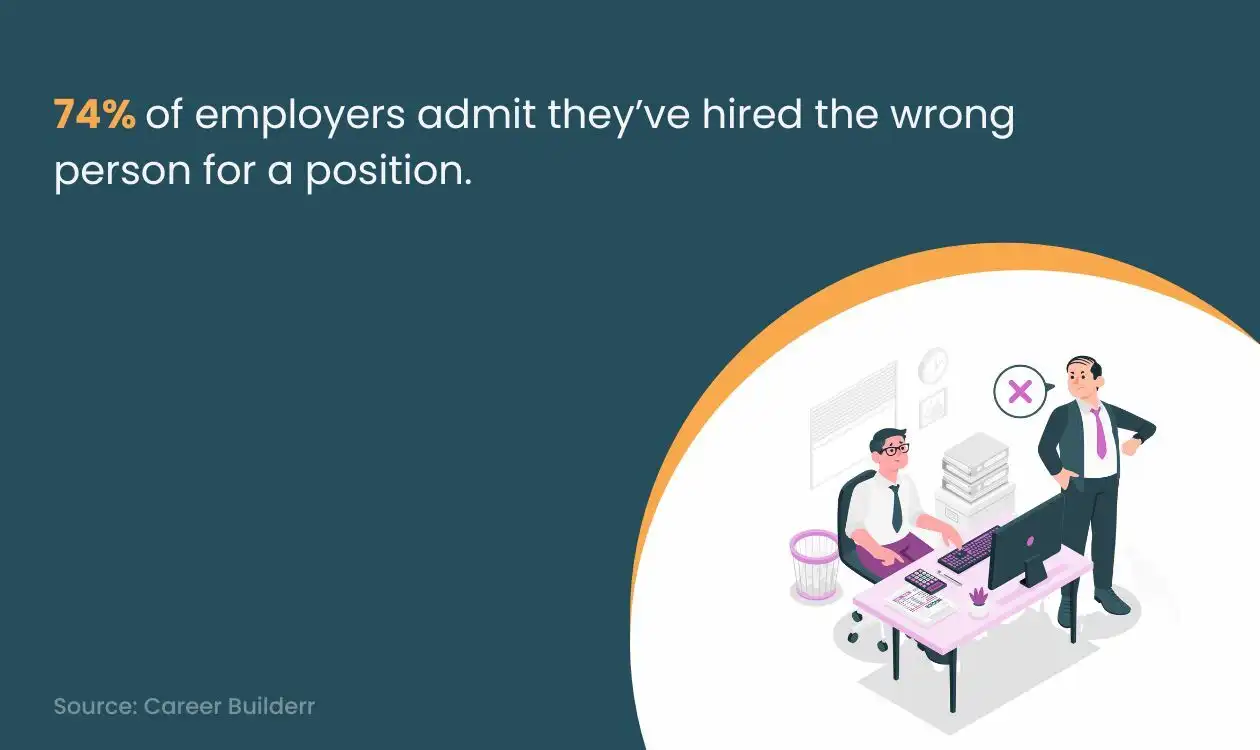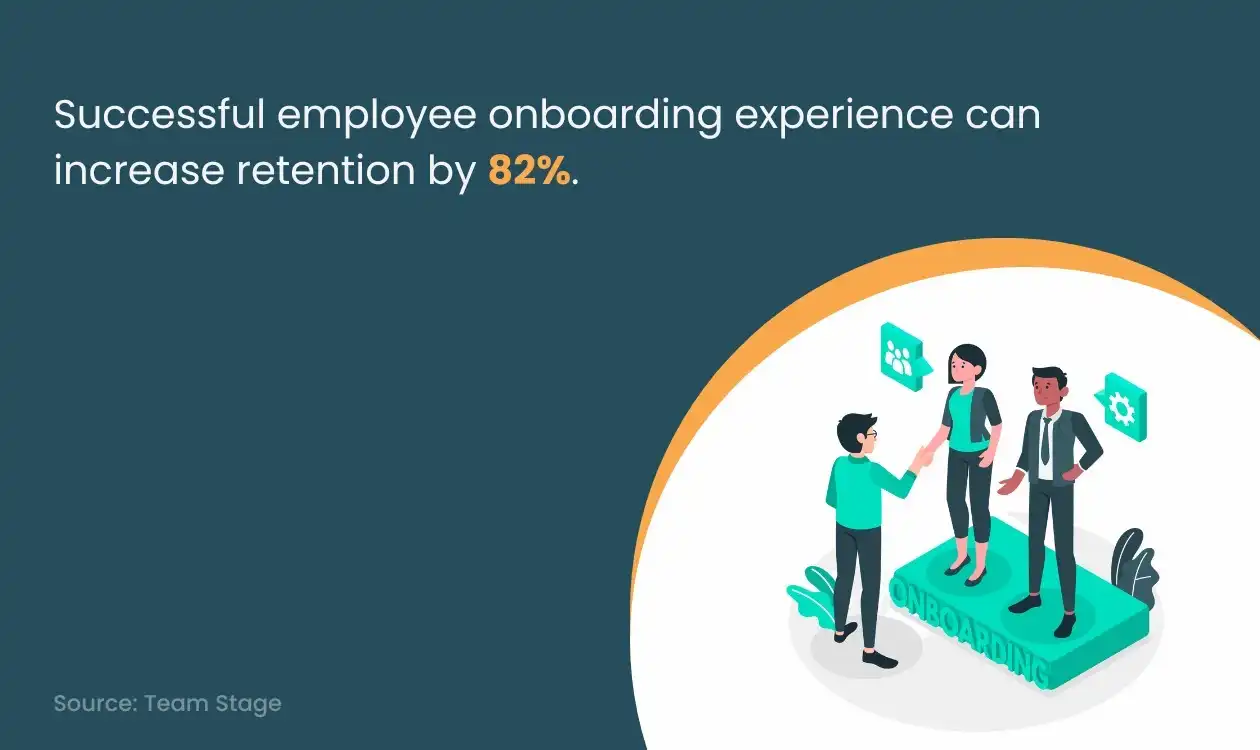Human Resources is a pivotal aspect of any successful organisation. HR creates a positive and productive work environment by helping employees grow, ensuring they follow the law, and managing data.
Despite the diverse duties, recruitment remains at the core of HR's efforts. HR professionals carefully find, screen, and evaluate potential hires to build a talented and diverse team. By focusing on recruitment, HR contributes to the overall strength and dynamic of the company.
One of the most vital contributors to a company's success is the quality of its hires.
The recruitment and selection process has to be carefully planned and executed to do this well. This includes considering a candidate's skills, experience, and fit with the company culture. By doing this, a company can save money, keep employees longer, and have a better reputation.
According to research, companies that take their hiring process seriously have a better chance of finding and retaining top talent, which helps them stay ahead of the competition and reach their goals.
In this article, we'll talk about the steps of hiring and selecting people, as well as why this is the most important HR function.
Steps Involved in the Recruitment and Selection Process
The recruitment and selection process in Human Resource Management is a multi-step journey that encompasses sourcing, screening, evaluating, and integrating new hires into the company. Understanding the difference between recruitment and selection and each step involved in the process is vital for organisations to ensure a successful outcome.
The recruitment and selection process in HRM, which involves various methods, is crucial in attracting top talent. Understanding the key steps in the selection process can help HR managers navigate the full recruitment life cycle and achieve the best outcomes.
1. Pre-recruitment Planning
Pre-recruitment planning is a crucial step that occurs before the actual hiring process begins. It's all about getting ready and setting everything up for success.
This step involves understanding what kind of employees the company needs now and in the future.
Here’s how it works: The HR team sits down and looks at the company’s goals and plans. They ask questions like,
-
What new projects are coming up?
-
Are we expanding into new areas?
-
What skills will we need to make all this happen?
Answering these questions helps them figure out not only which positions need to be filled immediately. It also helps them plan for hiring needs that might come up later.
Once they have a clear picture of the current and future staffing needs, they can create detailed job descriptions. To decide on the qualities they want in new employees.
This preparation makes the rest of the recruitment process smoother. Which ensures that the company attracts the right kind of talent.
In short, pre-recruitment planning is about being proactive rather than reactive.
It helps ensure that the company doesn't just fill positions for the sake of it but hires people who will help it grow and succeed in the long run.
2. Job analysis and Designing Job Descriptions
Job analysis and job design are considered the first and most important steps in the recruitment and selection process.
Job analysis involves the examination of the job duties, responsibilities, and requirements to determine the skills and knowledge needed to perform the job effectively. This information is used to craft an effective job description and a written document outlining the position's key responsibilities, requirements, and expectations.
Job descriptions are important tools for organisations in the recruitment and selection process as they provide a clear understanding of the position and its requirements.
This information is used to attract and screen potential candidates, to ensure that they meet the minimum qualifications for the position. Additionally, job descriptions are useful for establishing performance expectations and evaluating employee performance once they are on the job.
Job analysis and description help HR managers make informed decisions about compensation, employee training, and compliance with labour laws. A clear and detailed job description can also help attract and retain top talent by accurately communicating the role's expectations and responsibilities.
According to the Job Analysis and Job Description Survey Report by the Society for Human Resource Management (SHRM), when companies do thorough job analyses and write detailed job descriptions, they tend to get more qualified applicants.
The survey showed that companies with clear job descriptions get 20% more applicants on average, and these applicants are often better qualified for the job. The survey also found that having a detailed job description helps bring in more applicants and cuts down on the time and money needed to find and hire the right person.
3. Advertising vacancies
Once the Job Descriptions are fully developed, the next step is to advertise vacancies. This step involves the promotion of job openings to potential candidates to attract a large talent pool of qualified applicants. Organisations use various methods to advertise vacancies, including job boards, print media ads, professional networks, and social media to reach the right audience and generate interest in the position. Before advertising the job vacancy, it is essential to understand the job requirements, responsibilities, and expectations clearly.
And with iSmartRecruit, you can create and Inform job seekers about the newest openings over several platforms, including Social media platforms.
Here are some quick and full-proof tips for advertising vacancies:
1. Choose the Advertising Channel
Choose where to post the job ad, whether it's online, in print, or both. It's important to remember that the way you advertise should match the audience you're trying to reach and the position you're trying to fill. For instance, a company might choose to post an ad for a technical job on a professional networking site and a job for customer service on a job board or in local newspapers.
2. Write the Job Ad
Make sure to include the job title, location, salary, and a brief description of the job responsibilities. Highlight the most important requirements and qualifications.
3. Use Keywords
Keywords are specific terms or phrases used to identify relevant information in a search, such as in a job search where keywords can help match a candidate's skills and experience with relevant opportunities. Use keywords in the job ad that have relevance to the job to increase its visibility in online searches.
4. Add an Eye-Catching Title
A title that accurately reflects the job is catchy, and is attention-grabbing and will attract more applicants.
5. Include a Call-to-Action
Encourage applicants to apply by including a call-to-action such as "Apply Now" or "Submit Your Resume."
6. Determine the Closing Date
Specify the closing date for applications and make sure to stick to it.
7. Review and Edit
Before publishing the job ad, review it and make any necessary edits.
Once the job ad is created and published, it is crucial to monitor and review the responses received and move forward with the selection process.
4. Screening Applicants
Screening applicants is the third step in the hiring and selection process. It means looking at the applicant's skills, experience, and qualifications to see if they meet the basic requirements for the job. This step is critical because it makes sure that only the best candidates are called in for interviews.
The screening process typically follows these processes:
1. Resume and application review
The first step in the screening process is to review the candidate's resume and application to assess their qualifications and experience. This includes checking for typos and errors and verifying their education and work history. Online Resume Management Software imports and parses thousands of resumes faster and detects the key information about the candidates.
2. Phone screening
The next step is to conduct a phone screening with the candidate. This is an opportunity to ask the candidate more detailed questions about their qualifications and experience and to gauge their communication skills.
3. Initial in-person or video interview
The next step is an in-person or video interview with the candidate, where more in-depth questions are asked about their experience, qualifications, and suitability for the role.
4. Reference and background checks
Before making a final decision, it's important to check the candidate's references and perform a pre-employment background check to verify their work history and criminal record.
5. Final interview
The final step in the screening process is a final in-person or video interview. The candidate can ask questions about the company and the role and discuss their qualifications and fit for the position.
The screening process aims to reduce the number of applicants to a number that can be managed easily. This will make it easier to do more in-depth evaluations later on in the hiring process. It is vital to ensure the employer spends time and money evaluating only the best and most qualified candidates. This will make it easier to do more in-depth evaluations later on in the hiring process.
5. Making Hiring Decisions as an HR
Making hiring decisions is a crucial step in the recruitment and selection process, as it determines which candidates will be offered the job. The steps involved in making hiring decisions typically include the following:
1. Review applications: Review the applications and resumes of the candidates who made it to the interview phase. Make a note of any relevant education, experience, and skills.
2. Evaluate applicant's fit: Evaluate the candidate's fit with the company culture, values, and work environment. Consider whether the candidates would be a good fit with the current team and whether they can do the work well with the other employees.
3. Assess qualifications: Assess the candidates' qualifications and experience to determine if they meet the requirements for the position. Consider their education, certifications, and relevant work experience.
4. Consider interview feedback: Consider feedback from the interviewers about the candidates' interview performance. Evaluate whether the candidate demonstrated good communication skills and whether they were able to answer questions effectively.
5. Consider references: Consider feedback from the candidates' references to better understand the candidate's work ethic, skills, and experience.
6. Make a decision: Based on the information gathered during the recruitment and selection process, decide who to hire. Consider the candidates' qualifications, skills, and fit with the company culture when making the decision.
7. Communicate the decision: Communicate the decision to the selected candidate and inform the other applicants about the outcome of the selection process.
6. Onboarding the New Employees
The onboarding process is a very critical part of recruitment, as it can determine employee retention and loyalty. According to the Aberdeen Group, when compared to companies without an onboarding program, those with one have a 54% higher rate of keeping new hires. The report also showed that companies with a good employee onboarding process have more engaged and productive employees.
Some common steps in a great onboarding process include:
1. Introduction to the team: Introduce new employees to their team and give them a tour of the office to familiarise them with the environment.
2. Review of company policies and procedures: This includes reviewing the company's code of conduct, safety policies, and procedures.
3. Job orientation and training: New employees are provided with job-specific training and orientation to help them understand their roles and responsibilities.
4. Equipment and technology set-up: New hires are provided with the necessary equipment and technology to perform their job effectively.
5. Review of benefits and perks: New employees are given a review of the company's benefits and perks, including health insurance, 401(k) plans, and paid time off.
6. Performance goals and expectations: New employees are given an overview of the company's performance goals and expectations and encouraged to discuss any questions or concerns they may have.
7. Ongoing support and feedback: Onboarding does not end after the first week, and ongoing support and feedback are provided to new hires to help them succeed in their role.
7. Post-hire Evaluation
Post-hire evaluation is an important part of the recruitment and selection process because it helps companies figure out how good their hiring decisions are. The post-hire evaluation's primary goal is to determine if the new employee is living up to the expectations set during the hiring process and if they are helping the organisation reach its goals and objectives.
Most of the time, post-hire evaluations happen after a new employee has been on the job for a few months. They may include performance reviews, setting goals, keeping track of progress, getting feedback, and coaching. Both the employee's manager and HR are involved.
The Difference Between Recruitment and Selection

Final Thought on the Recruitment and Selection Process
Recruitment and selection are crucial to ensure that organisations hire the best people for the jobs it has open.
It is a complicated process requiring HR professionals to know much about the legal, moral, and technical parts of recruitment and selection.
Ultimately, an organisation's success or failure depends on how well it recruits and chooses people to work there.
So, companies need to take the time to look at their current hiring policies and procedures to make sure they meet their hiring goals.
By using an effective recruitment strategy, companies can get the most out of their employees and give them an edge in their industry.
Investing in recruitment software can be a huge help when it comes to streamlining the end-to-end processes and workflows.
Do you want to know how?
Request a FREE demo today and take the first step towards succeeding in your recruitment and selection process. Streamline your hiring workflow now with iSmartRecruit and unlock undefeated efficiency and effectiveness.






.webp.dat)






